
概述
我们之道作为一个码农,不论其实现如何,功能怎样,写的一手清晰靠谱的代码是其代码功力的体现。好的、清洁的代码可以方便自己以后维护,让你的继任者马上能接手维护它,而不是给你檫屁股,被人戳脊梁骨、被骂垃圾代码。所以,写清洁地代码非常重要。
那么什么才是清洁代码的呢?不言而喻,清洁的代码就是可以让人易于人理解、易于更改、方便扩展的代码。写清洁的代码要常扪心自问:
为什么要这样写?
为什么要在这儿写?
为什么不换个写法?
Robert C. Martin在《代码整洁之道》一书中说过:

就算是的坏代码也能运行,但如果代码不干净,也能会让你的开发团队陷入困境。
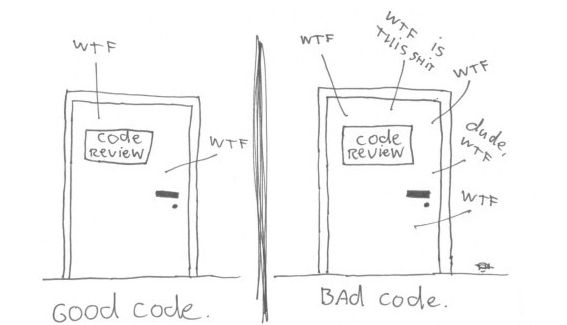
在本文中,虫虫就给大家讲讲JavaScript代码的整洁知道,全面对比下好的代码和坏的代码的写法。
强类型检查,使用"===",不用"=="
类型的检查非常重要,使用强类型检查可以帮我理清程序逻辑,如果类型检查松懈了(使用==),有可能使你的逻辑"南辕北撤了",试看下面的例子:
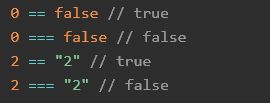
所以从现在开始就强类型检查,"亡羊补牢,犹未晚也"!
| const value = "520"; | |
| if (value === 520) { | |
| console.log(value); | |
| } |
条件不会满足。
| if (value === "520") { | |
| console.log(value); | |
| } |
条件满足。
变量命名
变量的命名要有意义,而不是随意乱起。最好是"望文生义",一看到变量名就知道是干嘛用的。
望文生义
坏代码:
| let daysSLV= 10; | |
| let y = new Date().getFullYear(); | |
| let ok; | |
| if (user.age > 30) { | |
| ok = true; | |
| } |
好代码:
| const MAX_AGE = 30; | |
| let daysSinceLastVisit = 10; | |
| let currentYear = new Date().getFullYear(); | |
| ... | |
| const isUserOlderThanAllowed = user.age > MAX_AGE; |
不要给变量添加额外不需要的单词
坏代码:
| let nameValue; | |
| let theProduct; |
好代码:
| let name; | |
| let product; |
不要让我们需要从上下文中了解变量的意思
坏代码:
| const ans = ["Chongchong", "maomaochong", "bollworm"]; | |
| ans.forEach(an => { | |
| doSomething(); | |
| doSomethingElse(); | |
| // ... | |
| // 等等,这个u是干嘛用的? | |
| register(an); | |
| }); |

好代码:
| const animals = ["Chongchong", "maomaochong", "bollworm"]; | |
| animals.forEach(animal => { | |
| doSomething(); | |
| doSomethingElse(); | |
| // ... | |
| // ... | |
| register(animal); | |
| }); |

不添加多余的上下文
坏代码:
| const user = { | |
| userName: "Chongchong", | |
| userNameAbb: "CC", | |
| userAge: "28" | |
| }; |
user.userName;
好代码:
| const user = { | |
| Name: "Chongchong", | |
| NameAbb: "CC", | |
| userAge: "28" | |
| }; | |
| ... | |
| user.userName; |
函数
使用长而具有描述性的函数名。
由于函数一般来说表示某种行为,函数名称应该是动词或短语,这样可以显示功能以及参数的意义。
坏代码:
| function notif(user) { | |
| // 代码逻辑 | |
| } |
好代码:
| function notifyUser(emailAddress){ | |
| //代码逻辑 | |
| } |
避免使用大量参数。
理想情况下,函数应该指定两个或更少的参数。参数越少,函数单元测试就越容易。
坏代码:
| function getUsers(fields, fromDate, toDate) { | |
| //代码逻辑 | |
| } |
好代码:
| function getUsers({ fields, fromDate, toDate }) { | |
| // 码逻辑 | |
| } | |
| getUsers({ | |
| fields: ['name', 'surname', 'email'], | |
| fromDate: '2019-05-22', | |
| toDate: '2019-05-31' | |
| }); |
使用默认参数,不用条件
坏代码:
| function createShape(type) { | |
| const shapeType = type || "circle"; | |
| // ... | |
| } |
好代码:
| function createShape(type = "circle") { | |
| // ... | |
| } |
一个函数做一件事。避免在单个函数中执行多个操作,多种逻辑
坏代码:
| function notifyUsers(users) { | |
| users.forEach(user => { | |
| const userRecord = database.lookup(user); | |
| if (userRecord.isVerified()) { | |
| notify(user); | |
| } | |
| }); | |
| } |
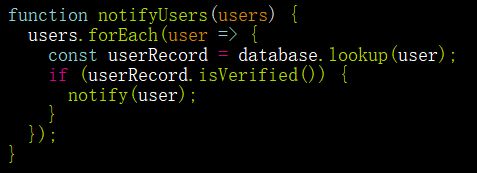
好代码:
| function notifyVerifiedUsers(users) { | |
| users.filter(isUserVerified).forEach(notify); | |
| } | |
| function isUserVerified(user) { | |
| const userRecord = database.lookup(user); | |
| return userRecord.isVerified(); | |
| } |
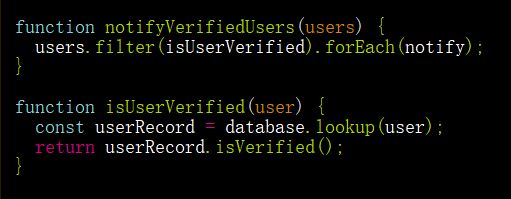
使用Object.assign配置默认对象
坏代码:
| const shapeConfig = { | |
| type: "cube", | |
| width: 200, | |
| height: null | |
| }; | |
| function createShape(config) { | |
| config.type = config.type || "cube"; | |
| config.width = config.width || 250; | |
| config.height = config.width || 250; | |
| } | |
| createShape(shapeConfig); |
好代码:
| const shapeConfig = { | |
| type: "cube", | |
| width: 200 | |
| }; | |
| function createShape(config) { | |
| config = Object.assign( | |
| { | |
| type: "cube", | |
| width: 250, | |
| height: 250 | |
| }, | |
| config | |
| ); | |
| ... | |
| } | |
| createShape(shapeConfig); |
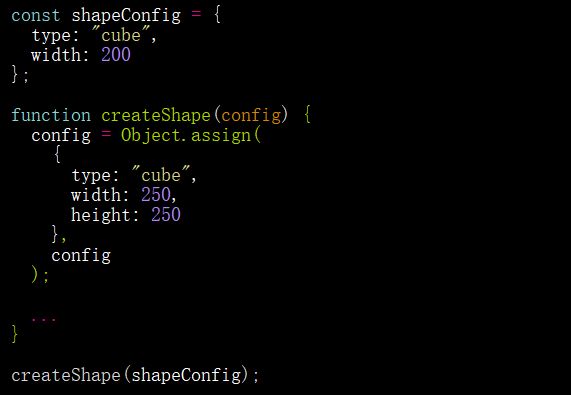
不要使用标志作为参数。
坏代码:
| function createFile(name, isPublic) { | |
| if (isPublic) { | |
| fs.create(`./public/${name}`); | |
| } else { | |
| fs.create(name); | |
| } | |
| } |
好代码:
| function createFile(name) { | |
| fs.create(name); | |
| } | |
| function createPublicFile(name) { | |
| createFile(`./public/${name}`); | |
| } |
不要让全局变量/函数污染
如果需要扩展现有对象,请使用ES类和继承,不要在对象原型链上创建函数。
坏代码:
| Array.prototype.myFunc = function myFunc() { | |
| // 代码逻辑 | |
| }; |
好代码:
| class SuperArray extends Array { | |
| myFunc() { | |
| //代码逻辑 | |
| } | |
| } |
条件
不要用否定句
坏代码:
| function isUserNotBlocked(user) { | |
| //代码逻辑 | |
| } | |
| if (!isUserNotBlocked(user)) { | |
| //代码逻辑 | |
| } | |
| 好代码: | |
| function isUserBlocked(user) { | |
| //代码逻辑 | |
| } | |
| if (isUserBlocked(user)) { | |
| //代码逻辑 | |
| } |
使用布尔变量直接判断,而不是条件语句
坏代码:
| if (isValid === true) { | |
| //代码逻辑 | |
| } | |
| if (isValid === false) { | |
| //代码逻辑 | |
| } | |
| 好代码: | |
| if (isValid) { | |
| //代码逻辑 | |
| } | |
| if (!isValid) { | |
| //代码逻辑 | |
| } |
避免使用条件,用多态和继承。
坏代码:
| class Car { | |
| // ... | |
| getMaximumSpeed() { | |
| switch (this.type) { | |
| case "Ford": | |
| return this.someFactor() + this.anotherFactor(); | |
| case "Benz": | |
| return this.someFactor(); | |
| case "BYD": | |
| return this.someFactor() - this.anotherFactor(); | |
| } | |
| } |
好代码:
| class Car { | |
| // ... | |
| } | |
| class Ford extends Car { | |
| // ... | |
| getMaximumSpeed() { | |
| return this.someFactor() + this.anotherFactor(); | |
| } | |
| } | |
| class Benz extends Car { | |
| // ... | |
| getMaximumSpeed() { | |
| return this.someFactor(); | |
| } | |
| } | |
| class BYD extends Car { | |
| // ... | |
| getMaximumSpeed() { | |
| return this.someFactor() - this.anotherFactor(); | |
| } | |
| } |
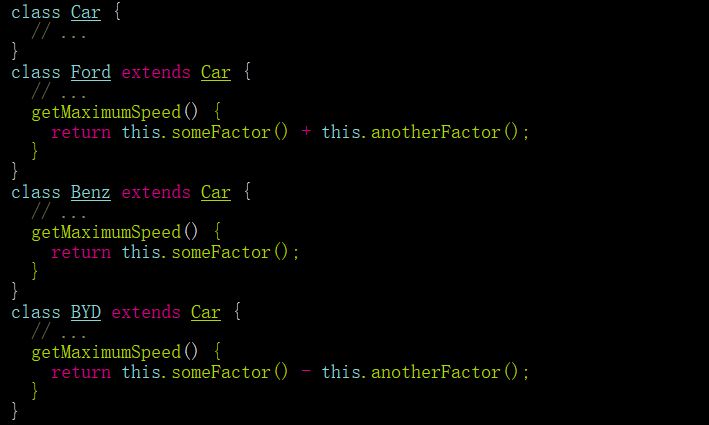
ES类
类是JavaScript中的新的语法糖。除了语法不同外,其他都和prototype一样工作。使用ES类可以让你的代码更加简洁清晰。
坏代码:
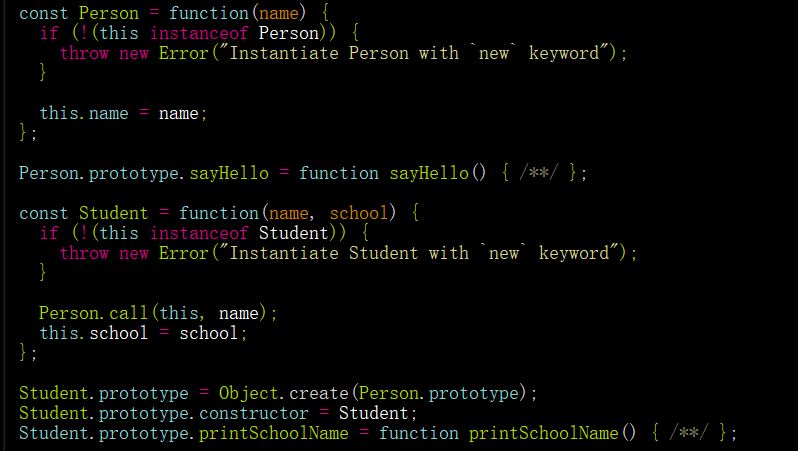
好代码:
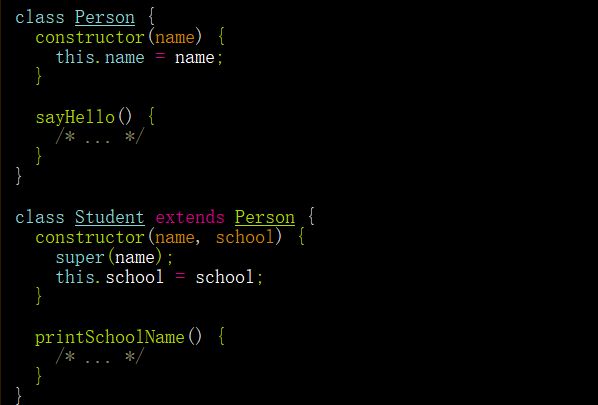
使用方法链接
许多库如jQuery和Lodash都使用该模式。因此,该方法可以让的代码简洁。在主类中,只需在每个函数的末尾返回"this",就可以将更多的类方法链接到该方法。
坏代码:
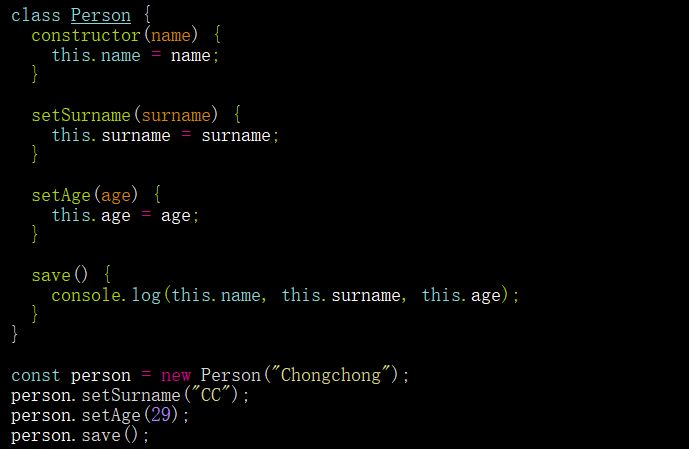
好代码:
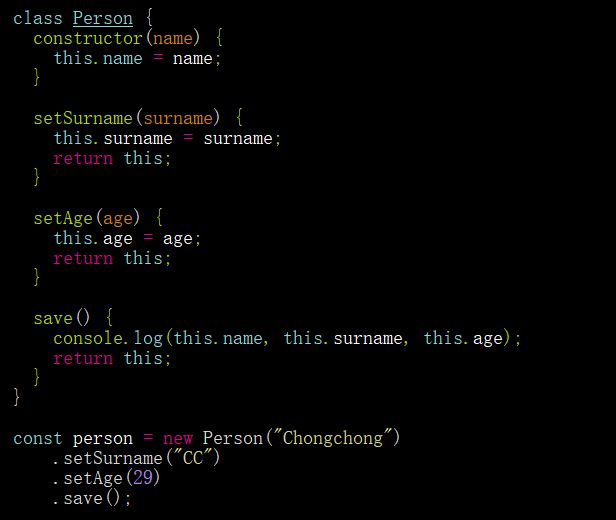
其他
通常情况下,尽量不要写不要重复代码,不要写不使用的函数和死代码。
出于历史原因,可能会遇到重复的代码。例如,有两段你略有不同的代码,但是有很多共同的逻辑,为省事或者赶工期,导致你复制了大段代码,略做小改然后使用了。针对这种代码,后期一定要及早抽象出相同逻辑部分删除重复代码越早越好,不要欠死账,不然后越积越多就不好处理了。
关于死代码,码如其名。就是啥事不干,删了可能引入错误,这和上面的一样处理,及早处理,不用了就早处理,早删除。
结论
上面只是代码整洁的部分原理,而且个别条款也可能需要商榷。这些大部分理论来源于《代码整洁之道》这本书。有什么建议意见请回复,一起学习讨论。